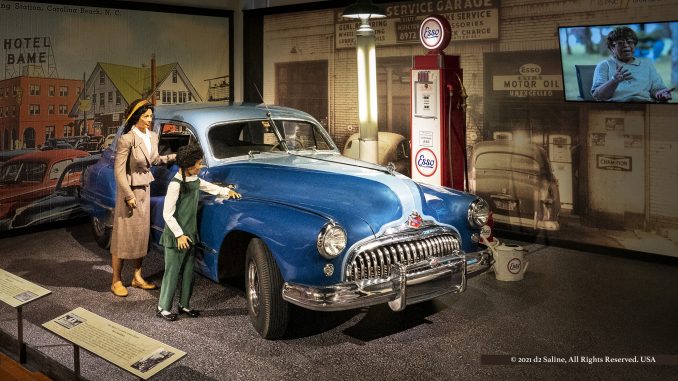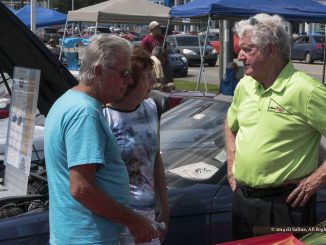
Racial disparities are sometimes felt more personally, if not shockingly, in the most pedestrian of objects and experiences.
Here in the land of the free, automobiles have come to symbolize that fundamental image of American life more than anything else. With his Model T, Henry Ford sought to make the dream of owning a car an accessible reality to the masses. In 1953, Dinah Shore encouraged her audiences to “See the USA in your Chevrolet!” [1,2]
During the last Mackinaw Policy Conference,” May Mobility co-founder Alisyn Malek used her paid sponsorship time on stage to pitch promised increase in access to mobility through comprehensive deployment of autonomous vehicles and smart city infrastructures. [3]
As aspirations go, all of these are indeed quite nice.
As observed about the “Automobile in American Life and Society” through a joint initiative by The University of Michigan at Dearborn and Benson Ford Research Center, “For blacks, as well as for whites, cars had real practical value — as a means of getting to work, of traveling, of visiting family and friends …. [4]
Perhaps most importantly, they helped blacks to escape the insults of Jim Crow …. [5]
For all of the “new mobility” of the car, driving still posed difficulties for blacks.
African American travelers regularly carried buckets or portable toilets in their car trunks because service station bathrooms and roadside rest areas were usually closed to them. Black motorists also found it difficult to find places to stay: most roadside motels — north and south — refused to admit blacks. Diners and fine restaurants alike regularly turned away black customers.
Back in those days the term “sundown towns” was common. And the “rules” of such venues “were simple: Black people were allowed to pass through during the day or go in to shop or work, but they had to be gone by nightfall. [6]
Anyone breaking the rules could risk arrest, a beating or worse.
Some insist the term archaic, no longer applicable to America today. Author James W Loewen has seventy-eight “possible sundown towns” listed for Michigan on his website. [7]
In 2014, Gilmore Car Museum in Hickory Corners opened a permanent exhibit centered on “The Green Book” as a starting point for discussion of issues that are themselves only a survey of racial discrimination viz automotive history and travel touched upon above. [8-11]
First published in the mid-1930s, “Victor Hugo Green published ‘The Negro Travelers’ Green Book’ with a listing of places — some commercial, some private homes — where dark-skinned people could stay and eat, where they could buy gas and even which towns to avoid for their own safety ….
Victor Hugo Green was a native of Hackensack, New Jersey and a mail carrier in New York City. His wife was from Virginia and as they traveled to visit family, they encountered Jim Crow restrictions. A Jewish friend showed Green a guidebook used to avoid “gentile-only” establishments and Green started his Green Book.
He enlisted mail carriers across the country to help him compile and update the listings.
The Negro Travelers’ Green Book remained in print even after the death of its creator, “until the passage of Civil Rights legislation in the 1960s.” [12]
Notably, the Gilmore Green Book diorama features an Esso gasoline pump associated with the John D Rockefeller Standard Oil Company. In a blog post for the museum, spokesman Jay Follis noted that Esso had had “a program to help African-Americans buy and operate its service stations. Esso also provided offices and support for the staff that helped Green produce and publish his guides.”
The Gilmore Car Museum is open seven days a week, year round; access to the Green Book exhibit is included as part of general admission. Visitors will also need to be familiar with and agree to abide by posted COVID-19 policies. [13-17]
This is an outstanding addition to what is said to be the largest auto museum in North America — well worth the visit. [18]
References
- “Ford Model T – 100 Years Later” CarDataVideo (August 12, 2008) YouTube.
- “Dinah Shore ‘See the USA in your Chevrolet’ – 1953” King Rose Archives (March 17, 2013) YouTube.
- “Mackinac Policy Conference 2019, Part 3: A renewed, competitive passion for multimodal transportation” Dell Deaton (May 31, 2019) Saline Journal.
- “Driving While Black: The Car and Race Relations in Modern America” Thomas J Sugrue, Automobile in American Life and Society (The University of Michigan at Dearborn and Benson Ford Research Center).
- “Jim Crow Museum of Racist Memorabilia” Ferris State University.
- “AP Road Trip: Racial Tensions in America’s ‘Sundown Towns’” Noreen Nasir, Tim Sullivan, and Maye-E Wong (October 15, 2020) Pulitzer Center.
- “Possible Sundown Towns in MI” Stephen Berrey and Phil Huckelberry (2020) The Homepage of James W Loewen.
- Gilmore Car Museum (home page).
- “Oscar Winner ‘Green Book’ Permanent Exhibit” (November 14, 2018) Gilmore Car Museum.
- “The Green Book: The Black Travelers’ Guide to Jim Crow America” Evan Andrews (March 13, 2019) History.
- “What to Know About the Controversy Surrounding the Movie Green Book” Andrew R Chow (February 24, 2019) Time.
- “Civil Rights Legislation and Supreme Court Cases” Martin Kelly (November 20, 2019) Thought Co.
- “Hours & Admissions” Gilmore Car Museum.
- Coronavirus (COVID-19) (home page).
- “Coronavirus Disease 2019 (COVID-19)” CDC: Centers for Disease Control and Prevention.
- “Novel Coronavirus Reports” CDC.
- “COVID-19 Policy Information” Gilmore Car Museum.
- “History and Mission” Gilmore Car Museum.



